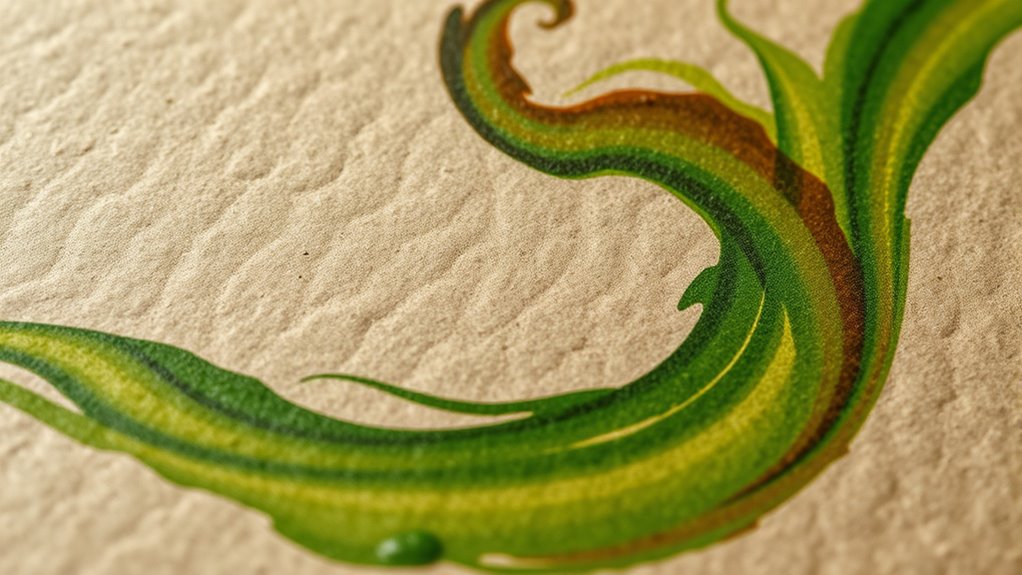Using sustainable materials and eco-friendly inks in your print projects helps reduce waste, lower emissions, and appeal to eco-conscious consumers. Recyclable substrates like post-consumer paper and biodegradable plastics support the circular economy, while plant-based inks such as soy or corn reduce harmful chemicals and VOCs. Switching to these options may require adjustments, but you’ll benefit from a cleaner environment and long-term savings. Keep exploring to discover how these choices can strengthen your eco-friendly initiatives.
Key Takeaways
- Recyclable substrates like post-consumer paper and biodegradable plastics support waste reduction and a circular economy.
- Eco-friendly inks made from renewable plant-based pigments reduce VOC emissions and promote healthier indoor environments.
- Water-based and vegetable-oil inks are sustainable, biodegradable, and easier to clean, minimizing chemical runoff and pollution.
- Combining sustainable materials with eco-friendly inks conserves resources, appeals to eco-conscious consumers, and enhances brand loyalty.
- Transitioning to sustainable options may require adjustments but offers long-term environmental benefits and compliance with regulations.

As awareness of environmental impact grows, choosing sustainable materials and eco-friendly inks has become essential for reducing your ecological footprint. When selecting printing substrates, opting for recyclable substrates is a smart move. These materials are designed to be reused or repurposed after their initial use, minimizing waste and conserving resources. Recyclable substrates include paper made from post-consumer waste, biodegradable plastics, and other materials engineered for easy recycling. By integrating these options into your printing processes, you help guarantee that your projects align with eco-conscious values and contribute to a circular economy.
Choosing recyclable substrates supports sustainability and promotes a circular economy in printing.
In addition to recyclable substrates, the inks you choose play a critical role in sustainability. Eco-friendly inks often feature plant-based pigments, which are derived from renewable resources like soy, corn, or other plant materials. These pigments replace traditional petroleum-based inks, considerably reducing the emission of volatile organic compounds (VOCs) and toxic chemicals. Plant-based pigments are not only better for the environment but also offer vibrant, long-lasting colors that maintain their quality over time. Using these inks demonstrates your commitment to reducing environmental harm and supports healthier indoor air quality, especially in enclosed spaces where printing facilities are located.
Going further, selecting eco-friendly inks also means considering their manufacturing process. Many are produced using sustainable methods that consume less energy and generate fewer waste byproducts. Some formulations are water-based or vegetable-oil-based, making them biodegradable and easier to clean up after printing. This reduces chemical runoff and pollution, helping you meet stricter environmental regulations and standards. Furthermore, these inks often have a lower carbon footprint from production to application, reinforcing your efforts to operate more sustainably.
Combining recyclable substrates with plant-based pigments creates a powerful synergy for eco-conscious printing. This approach minimizes landfill waste, cuts down on harmful emissions, and conserves natural resources. It also appeals to consumers increasingly interested in environmentally responsible products, giving your brand a competitive edge. Transitioning to these sustainable options might require some adjustments, but the long-term benefits—cost savings, brand loyalty, and positive environmental impact—far outweigh the initial effort. Additionally, understanding the importance of dynamic communication exercises can help your team better articulate the benefits of eco-friendly choices to clients and stakeholders.
Frequently Asked Questions
How Do Eco-Friendly Inks Compare in Durability to Traditional Inks?
Eco-friendly inks generally match traditional inks in durability, but some may have slightly lower ink longevity. You’ll find that eco-friendly inks often provide vibrant color vibrancy, though it might vary depending on the specific formulation. With advances in technology, many eco-friendly options now guarantee your prints remain vivid and durable over time, making them a reliable choice without sacrificing quality or longevity.
Are Sustainable Materials Cost-Effective for Large-Scale Printing?
Are sustainable materials cost-effective for large-scale printing? Absolutely, especially with material innovation driving down costs. You can achieve significant cost savings over time by choosing eco-friendly options, as they often require less energy and produce less waste. Although initial investments might be higher, the long-term benefits, including brand value and environmental impact, make sustainable materials a smart, economical choice for large-scale printing projects.
What Certifications Should I Look for in Eco-Friendly Print Products?
You should look for eco-friendly print products with certifications from reputable programs like FSC, SCS, or Green Seal. These certifications guarantee your products meet strict environmental standards, confirming sustainable sourcing and eco-conscious manufacturing. Always check the certification labels to verify the product’s compliance. By choosing certified items, you demonstrate your commitment to environmental responsibility and ensure your print materials align with recognized environmental standards.
Can Eco-Friendly Inks Be Used on All Types of Printing Surfaces?
The proof is in the pudding—you can’t use eco-friendly inks on just any surface. Surface compatibility and ink absorption vary widely, so it’s essential to verify if the ink suits your material. Some eco-inks work well on paper and fabric but may not adhere properly to plastics or metals, leading to poor results. Always test and consult with your supplier to ensure your chosen eco-ink is a good fit.
How Do Sustainable Materials Impact the Print Production Process?
Sustainable materials impact your print production process by emphasizing responsible material sourcing, which often requires careful selection of eco-friendly options. You’ll notice a focus on waste reduction, helping you minimize excess and improve efficiency. This shift encourages more eco-conscious practices, potentially streamlining workflows and reducing environmental footprint. Overall, integrating sustainable materials promotes a greener, more efficient production process, aligning your business with eco-friendly standards and enhancing your brand’s sustainability commitment.
Conclusion
Switching to sustainable materials and eco-friendly inks isn’t just good for the planet — it’s making a real difference. Did you know that using eco-friendly inks can reduce volatile organic compound emissions by up to 80%? By choosing these greener options, you’re not only creating beautiful prints but also helping to combat pollution and preserve natural resources. Every small step counts, and your choice can inspire others to adopt more sustainable printing practices.









